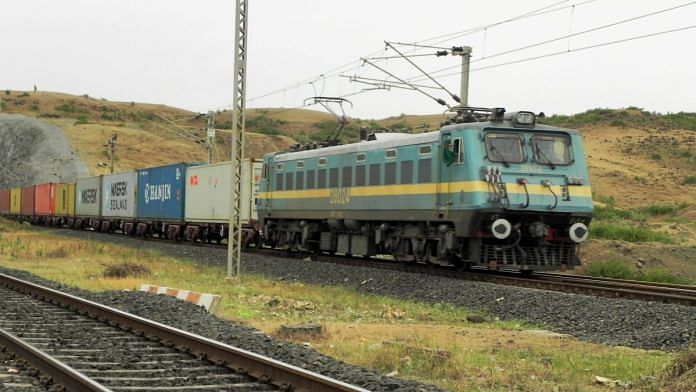New Delhi: The unrelenting decline in the Indian Railways’ ability to generate its own internal revenue despite the availability of adequate government support and infusion of funds via market borrowings points towards some inherent deficiencies in the system, a Parliamentary Committee has found.
According to a report by the Standing Committee on Railways, laid in Parliament last week and reviewed by ThePrint, the contribution of internal resources to the total capital outlay during 2020-21 was budgeted to be Rs 7,500 crore, which was reduced in the Revised Estimates (RE) to Rs 1,685 crore. The actual expenditure was Rs 2,062.04 crore.
This trend of budgeting higher initially and then revising it downwards was repeated in 2021-22, when the budget estimate (BE) was set at Rs 7,500 crore and reduced at the RE stage to Rs 2,500 crore. The actuals till 31 January, 2022, stood at Rs 1,422.95 crore.
This inability to meet budget targets for internal revenue generation, the committee said, led to greater dependency on market borrowings for the Indian Railways and is going to have a cascading effect in the long term.
“Taking into account various measures initiated by the Railways to leverage internal resource generation, the Committee suggests the Ministry prioritise accomplishing and commissioning of remunerative projects besides exploring other commercial avenues, like monetisation of airspace and vacant land, etc,” the panel said in its report.
In its reply to the panel’s queries, the Ministry of Railways said that there are constraints on the Railways to generate significant internal resources due to its huge social service obligation.
Moreover, the railways’ capacity to generate internal resources was hampered in 2016-17 and 2017-18 due to a sharp increase in staff costs and pension expenditure following the implementation of the recommendations of the 7th Central Pay Commission, the ministry said.
Also Read: India’s NE strategic rail link to LAC with China gathers pace, plans to connect 8 capitals too
Pandemic impact on revenues
In its response, the ministry said that while 2018-19 saw some improvement in internal resource generation with the stabilisation of working expenses and picking up of railway revenues, the adverse impact of the Covid-19 pandemic led to lower-than-projected revenue generation in 2019-20, 2020-21, and 2021-22.
“In expectation of a normal year in 2022-23, Railways have targeted to generate an internal resource of Rs 7,360 crore, out of which Rs 7,000 crore has been allocated for capex in BE 2022-23,” the ministry said.
Capex, or capital expenditure, is the money an organisation uses to acquire, upgrade and maintain its physical assets.
Additionally, the process of mobilisation of non-fare revenues (NFR) through asset monetisation, which could not take off due to Covid’s impact during 2020-21 and 2021-22, would also be taken forward, it added.
The parliamentary committee also noted that while the budget for Railways was increased substantially every year, they were not able to adequately utilise it, resulting in a huge “carry-over” of projects to subsequent years.
In its response, however, the Ministry of Railways claimed that, variations in budgetary allocation and actual expenditure notwithstanding, there has been a year-on-year increase in the actual capex incurred by the Railways.
For instance, in 2018-19, the Railways had utilised 91.3 per cent or Rs 1,33,377 crore against the revised allocation of Rs 1,46,058 crore, the ministry said in its response. In 2019-20, this utilisation increased to 96.6 per cent (Rs 1,48,064 crore) against the revised allocation of Rs 1,53,252 crore.
However, the next year, the actual expenditure as a proportion of the revised estimates fell to 96 per cent (Rs 1,55,181 crore) against the target of Rs 1,61,692 crore.
While the standing committee acknowledged the Railways’ efforts to increase their utilisation of the earmarked amount, it asked the ministry to use 100 per cent of the funds.
“Simultaneously, endeavours may be taken to do away with the delays caused due to non-availability of land from concerned state governments, non-availability of timely clearances, etc,” it said, reiterating its recommendation and emphasising that the ministry take proactive steps to achieve its capex target of the 2022-23 budget estimate for the projected expansion, upgradation, and modernisation of the railway network.
(Edited by Uttara Ramaswamy)
Also Read: Vande Bharat Express is changing Indian Railways. Now Indians need to do their bit



